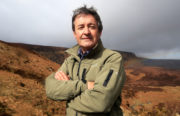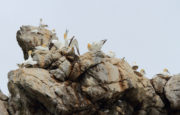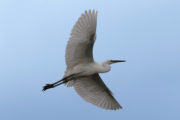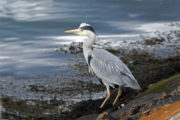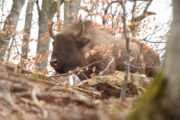On Sunday May 6th, RTÉ launches ‘Nature Live’, an ambitious new concept in wildlife programming, featuring stunning coverage of Europe’s most spectacular animals in their natural habitats. Like a Eurovision for wildlife, the show will broadcast live from seven breathtakingly beautiful locations all around the continent.
From the frozen Scandinavian Tundra to the mountains of Spain’s southern Atlantic coast; from Slovenia’s glacial lakes to Amsterdam skyscrapers; from Romania’s remote Carpathian mountains to Ireland’s historic Blasket Islands – Europe is home to a stunning variety of birds, animals and marine life, and this unique event will show viewers what is happening THIS VERY MINUTE in wildlife habitats right across the continent as leading wildlife broadcasters from Ireland, Spain, Netherlands, Slovenia, Romania and Norway will be standing by their satellite dishes, ready to beam pictures of nature as it happens.
From polar bears in Norway to basking sharks off the Blasket Islands, wild horses in southern Spain to chamois mountain goats in Slovenia and from peregrine falcons in the Netherlands to brown bears in Romania, this programme promises to be an amazing showcase for Europe’s diverse and wonderful natural world.
DUBLIN HUB
RTÉ favourite Derek Mooney (Mooney Goes Wild, RTÉ Radio One) hosts the show from a purpose-built stage on the edge of the Liffey – a location chosen to highlight Dublin’s status as the world’s ONLY capital city to contain a UNESCO-designated Biosphere – that means it is an area particularly rich in wildlife, where people and nature live successfully alongside each other.
(More on Biosphere below.)
NORWAY
Everyone loves a polar bear and the Norwegians, who have thousands of them roaming their Arctic fringes, are no exception.
Helge Söfteland is an avid wildlife enthusiast and seasoned broadcaster and has travelled north from Norway, half way to the Arctic Circle, to seek out some of the three thousand polar bears living on the islands of Svalbard. Helge will be accompanied at all times by a rifle-wielding ranger, in case a polar bear becomes too enthusiastic about meeting the presenter.
THE NETHERLANDS
The Netherlands is one of Europe’s most densely populated countries, but its wildlife continues to thrive. Menno Bentveld, presenter of the country’s most popular nature programme, trains his lens on a peregrine falcon’s sky-high eyrie, where a pair of the birds – the fastest creature in the world – is nesting on the rooftop of one of the city’s leading banks.
SPAIN
Doñana National Park is one of Europe’s most important wetland reserves. It sits on Spain’s southern Atlantic coast between the cities of Cádiz and Seville, in the province of Huelva. Wildlife presenters Lucía Mbomío and Luis Miguel Domínguez will be introducing viewers to the glossy ibis, a bird which bred in Europe for the first time as recently as 1977, and did so right here in Doñana.
Still a visiting species in Ireland, sightings are becoming ever more common.
The park is also home to herds of wild marsh horses, or Marismeño – the ancestral cousins of American Mustangs, and now an endangered species.
SLOVENIA
Triglav National Park in the Slovenian Alps is home to the Alpine Chamois – a mountain goat-antelope. As the snows melt, the chamois moves from its over-winter forest shelter onto higher slopes. Presenter Mojca Mavec is further down the mountain, on the shores of a majestic glacial lake, waiting for a chance to learn more about the elegant but elusive beast. Mojca will also be introducing viewers to the black grouse, a bird that is much more of an exhibitionist, performing a spectacular mating ritual en masse at this time of year.
ROMANIA
Romania’s Carpathian Mountains are home to five thousand brown bears, Europe’s largest population outside of Russia. Loved worldwide, the brown bear is in fact feared in Romania and the animal is hunted under controversial culling policies. Presenter Dite Dinesz takes to the hills to see these huge animals in their native, wild and dangerous environment.
Dite also tracks down Europe’s largest living wild land mammal – the European bison. Extinct in this area for 200 years, the species is being gradually reintroduced to the area and integrated into the ecosystem, as part of the biggest-ever bison reintroduction and transportation programme to have taken place in Europe.
IRELAND
Ireland’s waters are shark-infested! It’s absolutely true, but nothing to be afraid of.
Basking sharks are the biggest fish in the North Atlantic, and the second-largest in the world (they are not mammals, like whales). In spring and early summer these huge but harmless plankton-feeders arrive in significant numbers around the Irish coast, making it one of the best places in Europe to spot them. Wildlife filmmaker and broadcaster, Colin Stafford-Johnson returns to Great Blasket Island, one of the most westerly points in Europe, in the hope of getting up close to these magnificent creatures.
DUBLIN BAY BIOSPHERE http://www.dublinbaybiosphere.ie
In 1981, Dublin became the world’s first capital city – and it is still the world’s only capital city – that is home to a UNESCO-designated Biosphere – a site that’s especially rich in wildlife, where people and nature live successfully alongside each other.
The city is home to over one hundred and twenty species of bird, a unique mixture of marine and land mammals, lizards, frogs, and some of Europe’s most beautiful and most vulnerable insects. Across the entire city there are thousands of species thriving.
Close to the mouth of the Liffey is Bull Island – an array of protected habitats that is an EU designated Special Area of Conservation. This small sand-spit island, the result of human intervention in Dublin Bay, is a haven for international birdlife, especially migrating pale-bellied brent geese that fly up to ten thousand kilometers in a year to avoid harsh winters in the Canadian Arctic. There are also seals, orchids and the internationally important marsh fritillary butterfly.
Ireland’s Eye is a tiny island that is uninhabited by humans, but teeming with birdlife. It is home to a small number of puffins. You’ll see – and hear – thousands of cliff-nesting seabirds – kittiwakes, fulmars, razorbills and guillemots. There are over 350 pairs of gannets nesting here, and the world’s fastest animals, peregrine falcons, hunt overhead.
The Dublin Bay Biosphere is one of the jewels in the crown of European conservation.
Nature Live airs on Sunday, 6th May at 6.30pm on RTÉ One.
